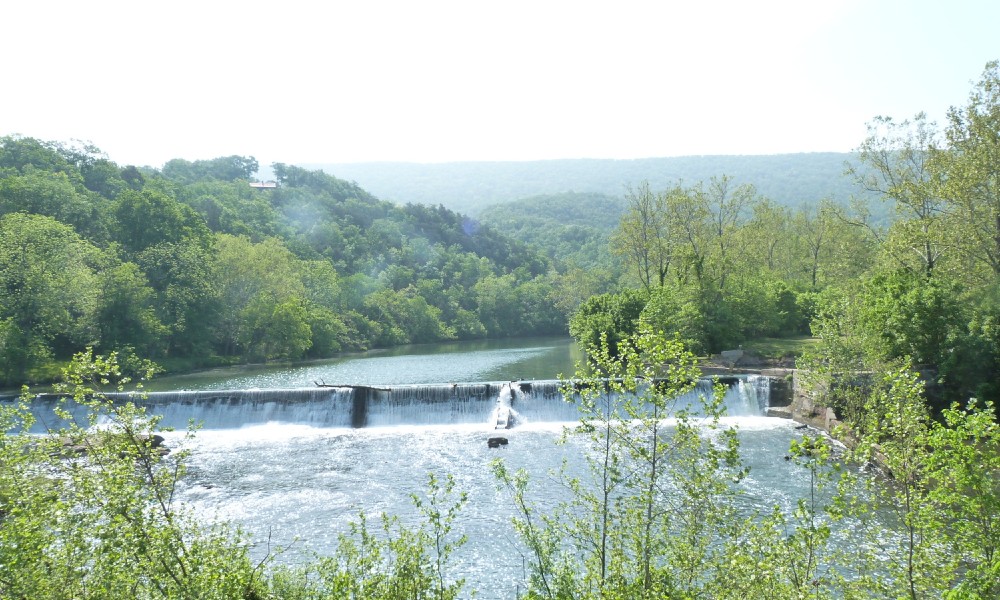Emergency drought plan showcases impact of ISAT capstone project
News
When the drought gripped Strasburg, Virginia, in 2023, a long-dormant capstone project suddenly sprang back to life, helping the town avert disaster.
The solution emerged years before, when three JMU Integrated Science and Technology (ISAT) majors, Alex Pineda ('16), Alex Barnes ('16), and Ricky Rizzo ('16), developed a solution to address the drought challenges faced by the small town in Shenandoah County. Under the guidance of ISAT professor Carole Nash, the team collaborated with Lee Harvey, the owner of Burnshire Hydroelectric, to revitalize Burnshire Dam, which powered Woodstock until 1956.
In 2012, Harvey purchased the aging Burnshire Dam to restore it using state-of-the-art generators – to preserve a historic site and modernize hydroelectric power in the Shenandoah Valley.
During the early 1900s, many dams were constructed to supply hydroelectric energy and create reservoirs for small towns in the valley. Over the years, most of these dams ceased energy production due to aging infrastructure and the introduction of a centralized power grid supplied by cooperatives or companies.
Initially focusing on hydroelectricity, Pineda, Rizzo, and Barnes were the first of several student groups to work at Burnshire. Originally planning to test the generators, they adapted their approach when the delivery of the generators was delayed, instead shifting their attention to the water powering them.
Burnshire Dam, known as a "run of river" operation, diverts some of the flow of the North Fork of the Shenandoah River to the generators while the excess water runs over the dam. Behind the dam lies an "impoundment" - a reservoir of water collected over time. During discussions with Harvey, the team learned about Strasburg’s reliance on the North Fork for its water supply and the challenges of low water periods, which were becoming more common.
"We recognized the reservoir’s potential for supplying water,” Pineda said. “We redirected our focus to help address this problem."
To assess the impoundment’s capacity, the team conducted over 30 depth measurements in the pool behind the dam from a canoe. They analyzed the river’s water levels using data from stream flow gauges monitored by the U.S. Geological Survey and identified regular periods of decreased water flow. Together, these data points allowed an estimated 37,000,000 gallons of water capacity in the impoundment.

Discussions with stakeholders and legal experts, including town officials and the Virginia State Hydrologist, addressed potential implications and impacts. In comparing the impoundment capacity with water usage, the students found that the dam could supplement Strasburg's water demand for 23 days.
The ambitious plan sat dormant – until the 2023 drought hit the Valley. Strasburg’s water plant director contacted Burnshire Hydroelectric, recalling the students’ proposal.
Using the team’s findings, Harvey released 40 cubic feet of water per second for ten days. According to the Virginia Department of Environmental Quality (VA DEQ), the students' plan proved pivotal and accurate. Strasburg lifted its declaration of a Drought Emergency on September 27.
The work of Alex Pineda, Alex Barnes, and Ricky Rizzo illustrates the impact of the ISAT capstone project, demonstrating real-world solutions to daily problems. “The capstone experience allows students to showcase their understanding of complex systems and problem-solving skills, making a meaningful impact even in times of crisis,” says Nash.
Harvey describes the restoration of the dam and bringing a new green energy source as a “win/win/win/win for us, our future customers, the planet, and most importantly, our children.”
Learn more about JMU's Integrated Science and Technology major.
